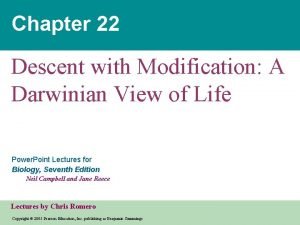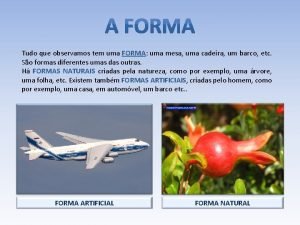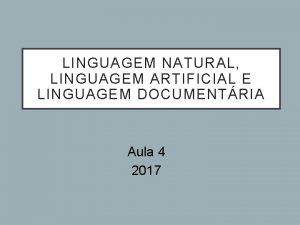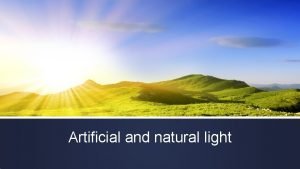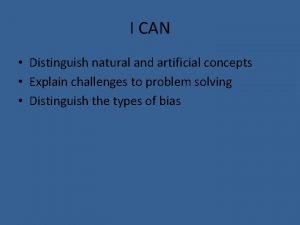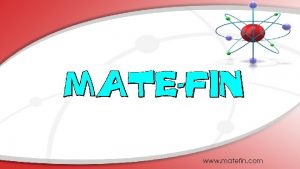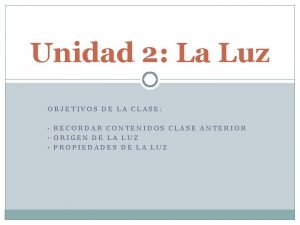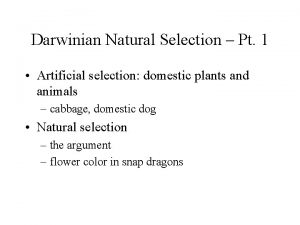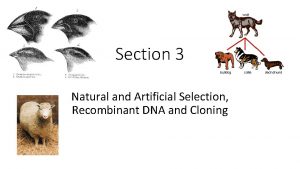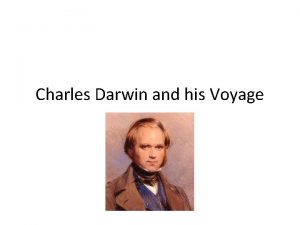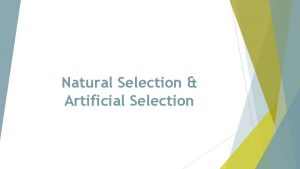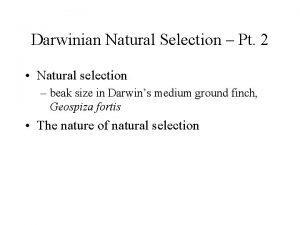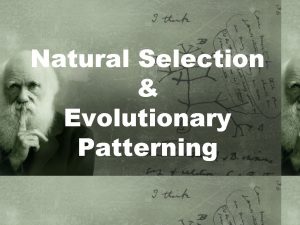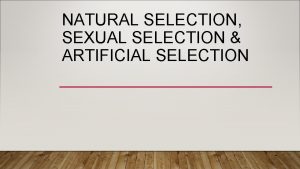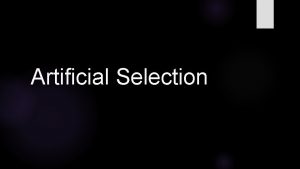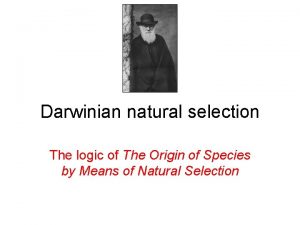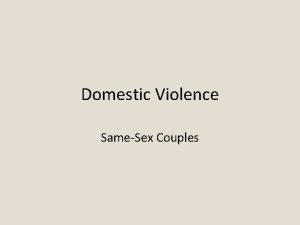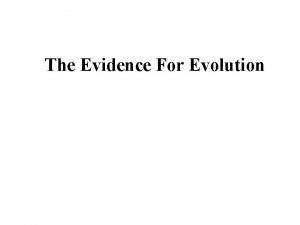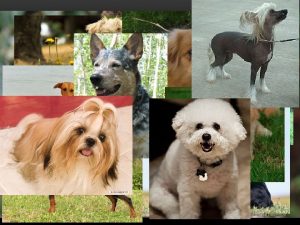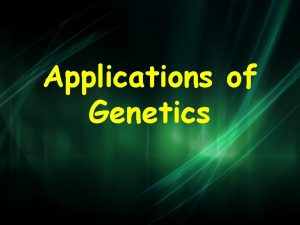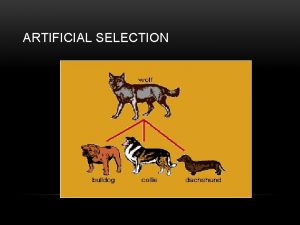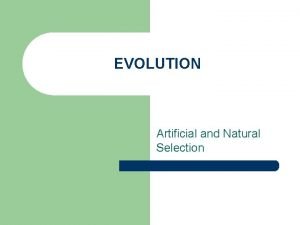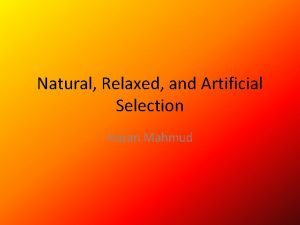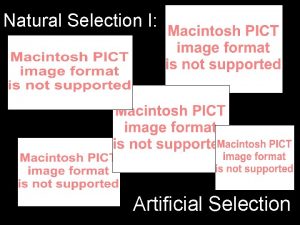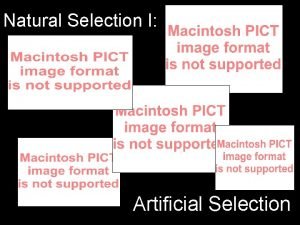Darwinian Natural Selection Pt 1 Artificial selection domestic





















- Slides: 21

Darwinian Natural Selection – Pt. 1 • Artificial selection: domestic plants and animals – cabbage, domestic dog • Natural selection – the argument – flower color in snap dragons

Artificial Selection – 1 • An analogy to natural selection • Chapter 1 of The Origin of Species – “Variation under Domestication”

Artificial Selection – 2 • Variation is the rule – “No case is on record of a variable being ceasing to be variable under cultivation. Our oldest cultivated plants, such as wheat, still often yield new varieties: our oldest domesticated animals are still capable of rapid improvement or modification. ” • Inheritance is common – “…the number and diversity of inheritable deviations of structure, both those of slight and those of considerable physiological importance, is endless…. No breeder doubts how strong is the tendency to inheritance: like produces like is his fundamental belief…. ”

Artificial Selection – 3 • Breeders choose individuals that have desirable characteristics to be the parents of the following generations (i. e. , breeders are the selective agent and the characters that they use to chose parents are the targets of selection) • If the selected trait is heritable then the breed or variety will come to express the selected trait to a greater degree, or completely new breeds and varieties can be created

Varieties of Cabbage (Brassica oleracea) Wild cabbage Cabbage Kohlrabi Broccoli Brussels sprouts Cauliflower

Fig 3. 2 Cauliflower phenotype in Arabidopsis

Dog breeds – A http: //www. akc. org/breeds_a. cfm

Dog breeds – C http: //www. akc. org/breeds_c. cfm

Domestic Dogs • > 400 described breeds • 152 breeds recognized by the American Kennel Club • Most modern breeds < 400 years old • Closest wild relative of domestic dogs is the gray wolf

Genetic Structure of the Purebred Domestic Dog. H. G. Parker, et al. 2004. Science 304: 1160 -1164 • 414 individuals from 85 breeds • 96 microsatellite loci • 27% of total genetic variation is among breeds (5– 10% among human populations) • Strong genetic isolation among breeds • Only 4 of 414 individuals assigned to wrong breed on basis of genotype • Possible to assign breeds to groups which often correlate with morphological similarity and shared geographic origin

Fig. 2. Consensus neighbor-joining tree of 85 dog breeds and the gray wolf. Nine breeds that form branches with statistical support are shown. The remaining 76 breeds show little phylogenetic structure and have been combined into one branch labeled "All other breeds" for simplification. The entire tree is shown in fig. S 1. The trees that formed the consensus are based on the chord distance measure. Five hundred bootstrap replicates of the data were carried out, and the fraction of bootstraps supporting each branch is indicated at the corresponding node as a percentage for those branches supported in more than 50% of the replicates. The wolf population at the root of the tree consists of eight individuals, one from each of the following countries: China, Oman, Iran, Sweden, Italy, Mexico, Canada, and the United States. Branch lengths are proportional to bootstrap values. Published by AAAS H. G. Parker et al. , Science 304, 1160 -1164 (2004)

Chinese shar-pei

Fig. 3. (A) Population structure of 85 domestic dog breeds. Each individual dog is represented by a single vertical line divided into K colors, where K is the number of clusters assumed. Each color represents one cluster, and the length of the colored segment shows the individual's estimated proportion of membership in that cluster. Black lines separate the breeds that are labeled below the figure. Representative breeds pictured above the graph from left to right: Akita, Pekingese, Belgian Sheepdog, Collie, Doberman Pinscher, Basset Hound, American Cocker Spaniel, Bedlington Terrier, Flat-Coated Retriever, Newfoundland, and Mastiff. Results shown are averages over 15 structure runs at each value of K. Published by AAAS H. G. Parker et al. , Science 304, 1160 -1164 (2004)

Evolution and Adaptation by Natural Selection: The Darwin-Wallace Argument • Postulate 1: There is variation among individuals • Postulate 2: Some of the variation is heritable • Postulate 3: In every generation some individuals are more successful at surviving and reproducing than others —the “struggle for existence” (see Chapter 3 of the “Origin”) • Postulate 4: The survival and reproduction of individuals are not random. Individuals with the most favorable variations, those who are better at surviving and reproducing, are naturally selected.

Evolution and Adaptation by Natural Selection: The Darwin-Wallace Argument - 2 • If these 4 postulates are true (and if favorable variations are heritable), then a population changes from one generation to the next as favorable variations spread through the population.

Evolution and Adaptation by Natural Selection: The Darwin-Wallace Argument - 3 • The selective agent is the environment (= nature), or something in the environment, in the broadest sense. • The targets of selection are any traits or characteristics that influence the chance that an individual will survive and reproduce • An adaptation is a phenotype that increases the likelihood that an individual will survive and reproduce • Adaptations spread through populations under the influence of natural selection provided that they are heritable • Natural selection (+ heritability) is a process that produces descent with modification (= evolution)

The Evolution of Flower Color in an Experimental Snapdragon Population – 1 • Jones, K. N. & J. Reithel. 2001. Am. J. Botany 88: 447 -454 • Flower color – all yellow vs. white (with yellow spots) (Postulate 1) – monhybrid inheritance, white dominant (Postulate 2) • Experimental “garden” – genotypes planted in F 2 proportions • Plants pollinated by free-living bumblebees

The Evolution of Flower Color in an Experimental Snapdragon Population – 2 • Observations – Number of bee visits to each flower – Number of seeds produced

The Evolution of Flower Color in an Experimental Snapdragon Population – 3 • Results – Individual plants showed “considerable variation” in reproductive success both as pollen donors and as seed mothers (Postulate 3) – White flowers attract twice as many bees as yellow flowers (= non-random variation in reproductive success via pollen flow and seed set? ) (Postulate 4) – White flowers had slightly higher seed production (= non-random reproductive success as seed mothers) (Postulate 4)

The Evolution of Flower Color in an Experimental Snapdragon Population – 4 • Did the population evolve? – Proportion of yellow-flowered plants in the offspring declined to 23%

Fig. 3. 3 Experimental evolution in snapdragons
 Disruptive selevtion
Disruptive selevtion Artificial selection vs natural selection
Artificial selection vs natural selection Natural selection vs artificial selection
Natural selection vs artificial selection Natural selection vs artificial selection
Natural selection vs artificial selection Artificial selection vs natural selection
Artificial selection vs natural selection The darwin
The darwin Descent with modification: a darwinian view of life
Descent with modification: a darwinian view of life Estruturas naturais e artificiais
Estruturas naturais e artificiais Linguagem artificial
Linguagem artificial Lateral compensating curve
Lateral compensating curve Artificial and natural light
Artificial and natural light Mentalset
Mentalset Natural and artificial radioactivity
Natural and artificial radioactivity Radioactive decay law
Radioactive decay law Mapa conceptual atomo
Mapa conceptual atomo Fission and fusion similarities
Fission and fusion similarities Natural and artificial food additives
Natural and artificial food additives Difference between natural and artificial greenhouse
Difference between natural and artificial greenhouse Natural and artificial radioactivity
Natural and artificial radioactivity Natural selection 3
Natural selection 3 Artificial selection
Artificial selection How do species vary locally
How do species vary locally






